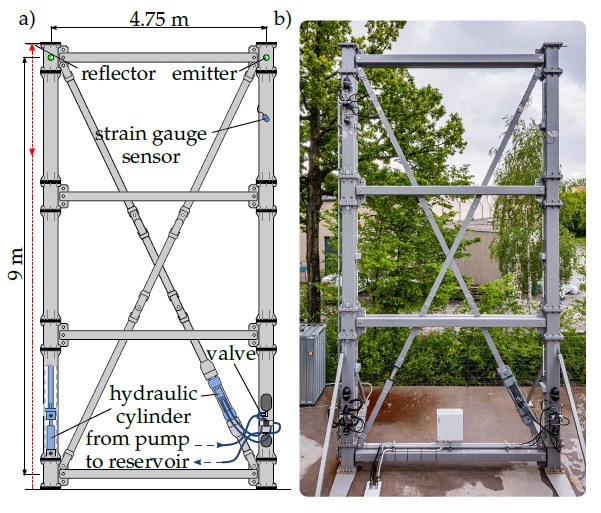About
16 March 2020
New Low-cost Approach Detects Building Deformations with Extreme Precision in Real Time
With the ability to detect submillimeter movements in real time, new method could be valuable for monitoring historic structures and adaptive buildings of the future
WASHINGTON — A new camera-based method for measuring building deformations can detect small displacements from 10 meters away. The method could be useful for continuously detecting fast deformations in high-rise buildings, bridges and other large structures with the aim of adapting these structures to external forces.
“Our new approach to detect building deformations could be used to continuously monitor movements. For bridges, the measured deformations could be used to counteract external loads such as a truck traversing the bridge, thereby increasing the lifetime of the bridge,” said Flavio Guerra from the University of Stuttgart, a member of the research team. “Because it operates in real time, it could be used to set off an alert the moment any new deformations – which can lead to cracks – were detected.”

Caption: The researchers applied their new camera-based method for measuring building deformations to monitor very small movements of an adaptive building prototype frame 9 meters tall.
Credit: Flavio Guerra, University of Stuttgart
Researchers led by Tobias Haist describe the new technique in The Optical Society (OSA) journal Applied Optics. The research was conducted as part of a project that aims to develop the technology necessary to create buildings that adapt to environmental conditions such as sunlight, air temperature, wind and earthquakes.
“One day we could have lightweight buildings that change forms in response to complex wind forces and can stay still during an earthquake,” said Guerra. “This type of adaptation requires extremely precise building deformation measurement so that the building’s current state is estimated and the direction in which it will likely move can be predicted.”
A vision-based method
The new method involves fixing a camera on a tripod a small distance away from the front of the building and attaching small light emitters to the building. The camera then detects whether the light sources move relative to each other. A computer-generated hologram is used to create multiple copies of each light source image on the image sensor. Averaging the movement of the multiple copies of the laser spot helps decrease measurement errors, such as noise, yielding measurement uncertainties below a hundredth of a pixel. Using multiple cameras would improve that accuracy even more and enable the technique to be used on very large structures.
Although fiber optic sensors can be used for structural health monitoring, they must be installed when the building is built. The new camera-based system can be attached after construction and uses hardware that is less expensive than fiber optic systems.
“The multi-point measurement approach we used is based on a relatively simple method developed for the control of coordinate measurement machines,” said Guerra. “However, we applied the multi-point method for the first time on large objects outdoors under changing environmental conditions in real-time.”
The researchers point out that most camera inspection systems illuminate the object — a building in this case — and then image it with a camera. They took a different approach by attaching light emitters to the building and directing the light directly toward the camera. This setup allows faster and more accurate measurements because the camera receives more light.
Monitoring an adaptive structure prototype
The researchers used their new method to monitor very small movements of an adaptive building prototype frame 9 meters tall. Their measurements matched well with vibrometer and strain gauge sensor data obtained for the prototype.
Next, the researchers plan to use the system to measure movement in real buildings. They also plan to make the software more robust and redundant so that it is reliable for continuous measurement 24 hours a day.
Paper: F. Guerra, T. Haist, A. Warsewa, S. Hartlieb, W. Osten, C. Tarín, “Precise building deformation measurement using holographic multipoint replication,” Applied Optics, 59, 9, 2746-2753 (2020).
DOI: https://doi.org/10.1364/AO.385594
About The Optical Society
The Optical Society (OSA) is dedicated to promoting the generation, application, archiving, and dissemination of knowledge in optics and photonics worldwide. Founded in 1916, it is the leading organization for scientists, engineers, business professionals, students, and others interested in the science of light. OSA’s renowned publications, meetings, online resources, and in-person activities fuel discoveries, shape real-life applications and accelerate scientific, technical, and educational achievement.
About Optical Materials Express
Optical Materials Express is an open-access journal focusing on the synthesis, processing and characterization of materials for applications in optics and photonics. It is published by Optica Publishing Group and emphasizes advances in novel optical materials, their properties, modeling, synthesis and fabrication techniques; how such materials contribute to novel optical behavior; and how they enable new or improved optical devices. The Editor-in-Chief is Andrea Alù from City University of New York, USA. For more information, visit Optical Materials Express.
Media Contact
